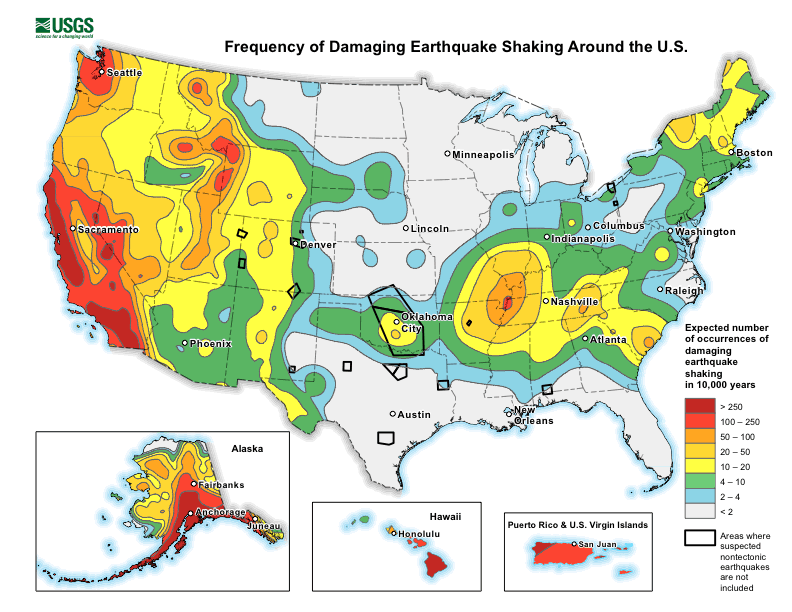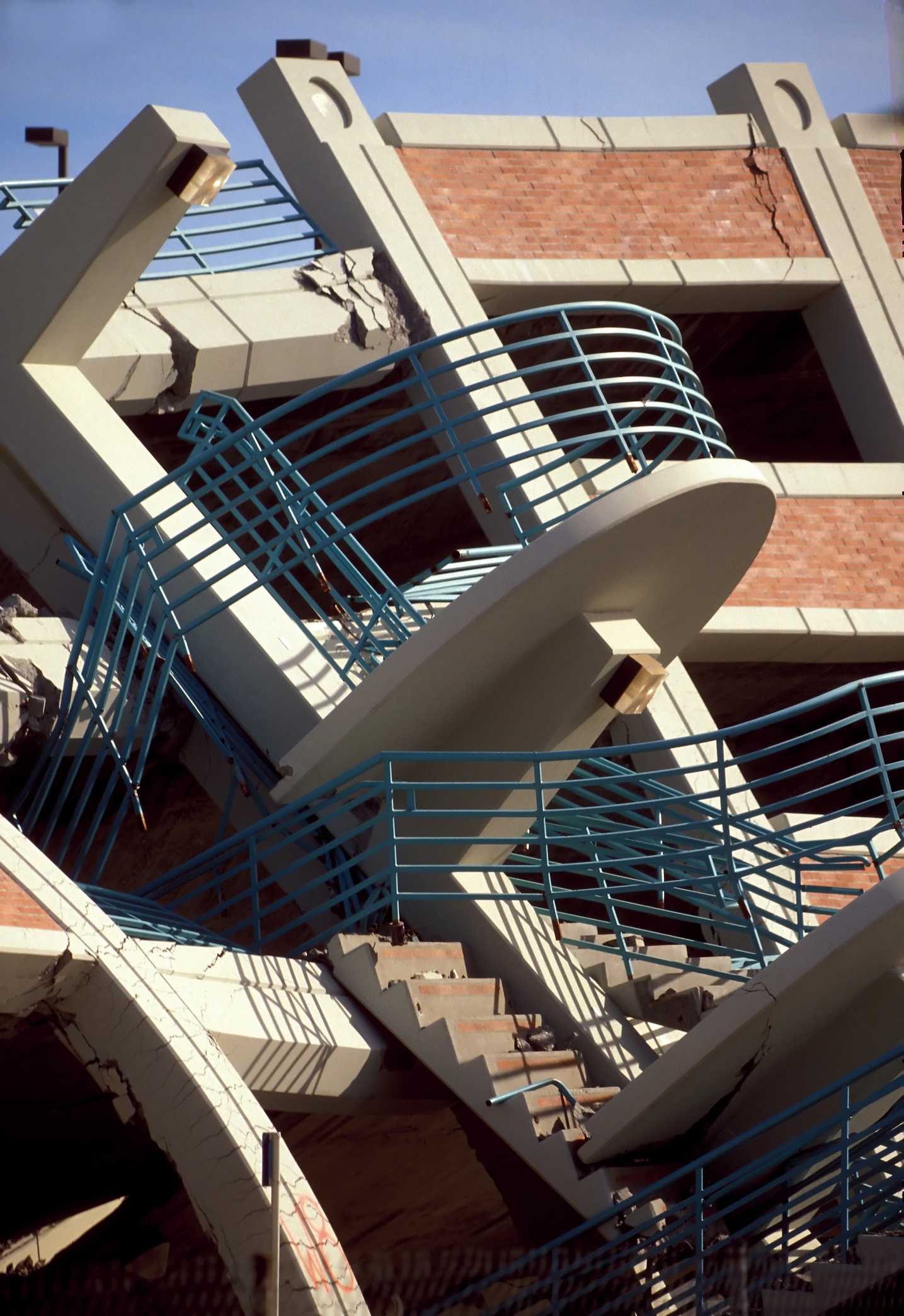PREPARATION IS CRUCIAL
Protecting employees and company property are necessary during an earthquake. One of the best ways to do this is through preventative measures. Staff can be trained for an earthquake specific emergency just like any other lifethreatening emergency. Preparedness is the best course of action. Companies located in high risk areas should conduct drills on a regular basis according to OSHA.
An earthquake is a sudden, rapid shaking of the earth caused by shifting of subterranean rock as it releases strain that has accumulated over a long time. Initial mild shaking may strengthen and become extremely violent within seconds. They strike without warning, at any time of year, day or night. Additional earthquakes, called aftershocks, may follow the initial earthquake. They may trigger landslides, avalanches, and tsunamis.
Forty-five U.S states and territories are at moderate to very high risk of earthquakes. The risk exists in identified seismic zones including the San Andreas Fault, the Cascadia Subduction Zone, the New Madrid Fault Zone, and areas on the east coast. Keep tight management controls on key or card access.
Below are some recommendations from FEMA and Ready.gov on how to prepare your business and employees for an earthquake emergency. Reviewing these will help better position your business in the event of an earthquake.
BEFORE AN EARTHQUAKE
PREPARE YOUR FACILITIES
Make your buildings safer to be in during earthquakes and more resistant to earthquake damage and disruption. Depending on when and how they were designed, built, and furnished, existing buildings may have weaknesses that make them more vulnerable to earthquakes.
Check with your local building-regulatory agency to find out whether, and for how long, structures in your area have been subject to building codes containing seismic design provisions. Facilities constructed before adequate provisions came into effect may have structural vulnerabilities.
It is also important to know whether and for how long local seismic code provisions have addressed nonstructural building components. Nonstructural items include utility systems and architectural elements (e.g., light fixtures, suspended ceilings, windows, partitions), as well as furnishings, supplies, inventory, equipment, and other building contents.
Nonstructural seismic weaknesses can be as or more dangerous, costly, and disruptive as structural vulnerabilities. Any nonstructural items that are not effectively anchored, braced, reinforced, or otherwise secured could become safety hazards or property losses in an earthquake. Design and construction professionals are needed to properly secure some of these components, while others can be made safe by maintenance staff or other employees.
Earthquake risk-reduction measures can range from inexpensive methods of securing building contents to expensive structural modifications. The mix of measures that is optimal for your facilities will depend on factors such as the potential severity of Below are some recommendations from FEMA and Ready.gov on how to prepare your business and employees for an earthquake emergency. Reviewing these will help better position your business in the event of an earthquake. the earthquake hazards in your locale, the current condition of your facilities, whether your workplace is owned or leased, and how vulnerable your operations are to facility damage and associated downtime.

This map illustrates the frequency of damaging earthquakes within a period of 10,000 years. Areas such as the Pacific Coast lie at fault lines, and are particularly prone to intense geologic activity. (Source: U.S. Geologic Survey)
DURING AN EARTHQUAKE
PREPARE YOUR COMMUNITY
It makes good business sense for employers to contribute to the well-being of the communities from which they recruit employees, clients, and customers. There are many ways that businesses, acting either individually or collectively through organizations such as local chambers of commerce, can help strengthen the disaster resilience of their communities. Some of these ways include serving as local exemplars of organizational preparedness; promoting preparedness among suppliers, clients, and other business contacts; and sponsoring or participating in local earthquake drills, preparedness events, or awareness and education campaigns.
PREPARE YOUR WORKFORCE TO:
React Safely
Every employee, from top managers to part-time and temporary workers, needs to learn What to Do During an Earthquake. Safety orientations should emphasize safe places to “drop, cover, and hold on” during earthquake shaking and safe locations where people can rendezvous when the shaking has stopped and it is safe and advisable to evacuate your facilities.
Hold periodic, mandatory earthquake drills to give employees opportunities to practice what they have learned and condition themselves to react spontaneously and safely when the first jolt or shaking is felt. To help protect workers in the immediate aftermath of earthquakes or other disasters, arrange for employees to be trained now in first aid, cardiopulmonary resuscitation (CPR), and the use of fire extinguishers. Earthquakes should be thoroughly integrated into the organization’s emergency preparedness, response, and recovery planning.
Help the Organization Survive a Damaging Earthquake
Elements that are critical to ongoing business viability vary from one organization to another. They may include, for example, locations, equipment, telecommunications, supply chains, stored data, or employee knowledge or skills. A prepared workforce is one that has identified the elements that are important to its operations; made plans for protecting, reconstructing, duplicating, or surviving without these elements; and been adequately trained to carry out these plans in the event of an earthquake or other contingency. Visit Ready Business for more information on business-continuity and contingency planning.
In the days following an earthquake, employees are more likely to be able to come to work and perform effectively if they are less worried about or preoccupied with their families and homes. They should be encouraged to prepare their homes and families in advance for earthquakes and other emergencies (see Earthquake Safety at Home).

AFTER AN EARTHQUAKE
Once the shaking stops, workplaces should be prepared to implement prearranged, earthquake-specific emergency response and recovery plans. Employees must keep in mind that aftershocks may strike at any time, exacerbating hazards created by earlier shaking and requiring that everyone again drop, cover, and hold on.
Regardless of the severity of this earthquake, learn from the experience. If there are things that your organization could have done better in preparing for this quake, do them better now in preparation for the next earthquake. If structures must be repaired or rebuilt, for example, use this opportunity to ensure that weaknesses are addressed and that new facilities are compliant with seismic building standards. If building contents were damaged, improve how such items are secured. If employees were insufficiently prepared to react safely, increase safety training and the frequency of drills.
As in any emergency event, we hope to never implement what we have been trained on and taught. However, because of the potential seriousness and significance an earthquake can cause it is absolutely in your best interest to be prepared and have all your employees prepared. California has been a leader in training and preparedness and has developed the Great Shake Out. All regions are encouraged to participate in International Shake Out Day on October 18, 2018. More details on this event and other Shake Out information can be found at https://www.shakeout.org/.